The Crusher
- allisonwerkema
- Aug 30, 2022
- 15 min read
~By Allison Werkema
“Car back!”
“What?! You’re kidding me, right?”
“No really, car back!”
“How the heck did they get here??”
“No idea…”
My riding partner and I were about 50 miles into our 254-mile adventure. Our preconceptions of what “gravel road” meant in Crusher-terminology had already been promptly shattered, beginning on mile one when we were faced with a very steep grade covered in Garmin- to helmet-sized rocks. Gravel road. Ha. I guess we were getting what we signed up for. The fact that some vehicles were able to traverse the stuff we were going through was scarcely believable.

This harebrained journey all started on July 25 when my mom sent me a screenshot of a Facebook post along with the message, “Sounds like someone you need to befriend…” The post was of a group of people, including two women, who were competing in an ultra-endurance race in the remote wilderness of Michigan’s Upper Peninsula called The Crusher. Intrigued, I perused the race website and was immediately hooked by the phrases used to describe the event: “Soul crushingly stout terrain,” “No one is out there to save you,” and “Do not underestimate the difficulty of this event.” Sounded like my kind of thing. I reached out to my friend Bill Shaver, and within a week, we were registered.

Fast forward to four weeks later, the morning of Friday, August 19, and we were finally ready to take off. We were on our mountain bikes, and they were loaded and clunky. Mine was decked out with a large saddle pack and a bar bag with a smaller accessory pack for snacks. Including the weight of my hydration pack and two liters of water, my bike and gear came in at a whopping 59 pounds, over twice the weight of my bike by itself. Bill had a similar set up with the addition of a frame bag, and although we never weighed his gear, we both figured it was probably even heavier than mine. Going into this, we both had the mentality of “better overprepared than underprepared,” as we were completely self-supported. The extra weight would prove painful, but given what would unfold later, I was glad we brought the gear we did.

Following a couple of minor logistical hiccups, Bill and I eventually were on the course around 6:00 AM. Racers have a three-month window in which they can attempt The Crusher, and we were the only ones on the “225EX” course that weekend. It was still pitch-black outside, and it did not take long for us to leave any fleeting signs of civilization behind. This was when I encountered my first major concern: My left iliotibial (IT) band was inflamed and rubbing against the bone in my knee, despite the ibuprofen I had taken an hour prior. This had been a major issue for me when I raced Ore to Shore the week before, and given how much pain I had been in then, I became highly doubtful that I would be able to finish this. Nevertheless, we continued to plug ahead, agreeing that we would reassess the situation once we reached the mouth of the Huron River along the shore of Lake Superior, at approximately mile 68.
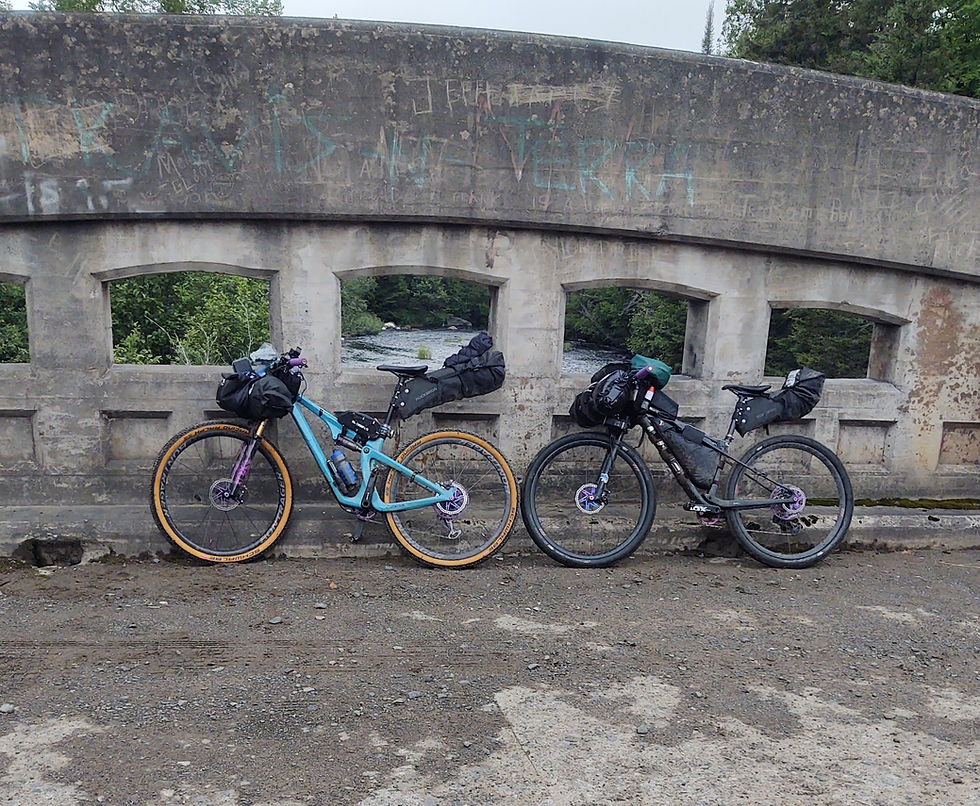
Getting to the Huron River was a long, slow, painful slog. The route we took was a mix of two-track, old logging roads, and actual gravel or dirt roads with some monster climbs thrown in. Many were washed out or just flat out underwater, as the area had seen close to four inches of rain the night before. It soon started to rain again, and the rain continued off and on for the rest of the day, accompanied by some severe thunderstorms and lightning strikes a little too close for comfort. Our shoes and feet were soon soaked, and they stayed that way for the next 60 hours. With as many water crossings as we encountered, we soon gave up trying to keep ourselves dry. The number of times we were forced to “hike a bike” probably made up over a quarter of the time we were on the course, often due to extreme terrain or murky, waist-high water that was unrideable.
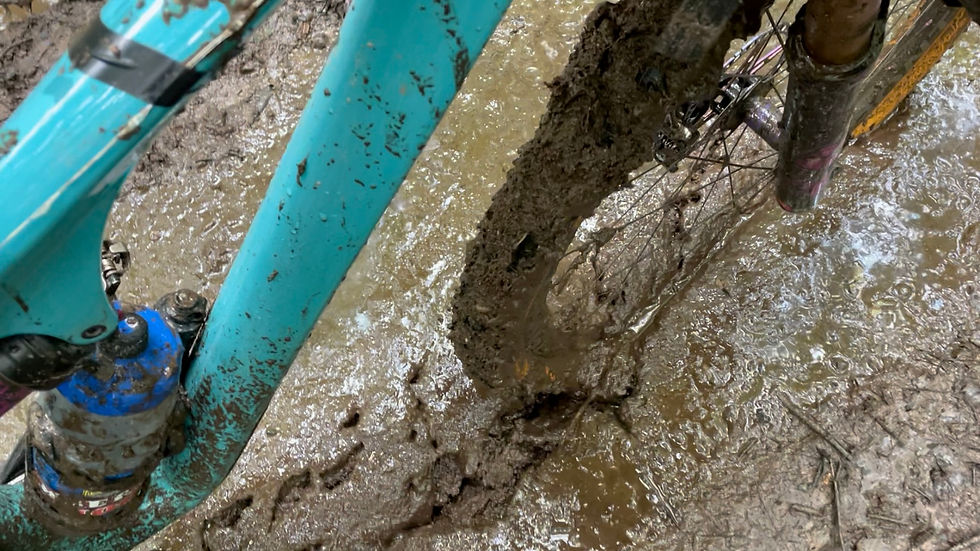

Finally, we arrived at the mouth of the Huron River. After popping some more ibuprofen and filling our hydration packs with water we filtered straight from Lake Superior, I decided my knee was well enough to continue on, and we ambitiously hoisted our bikes over our heads as we trudged across the pristine water. A couple of bewildered locals who had arrived at the shore via side-by-sides watched us with some concern, which I had to laugh at. They left soon after we crossed to the opposite shore, saying that a storm was rolling in and they were going to take shelter. By this point, my iPhone was down to 30% battery. Our Garmins were already dead due to technical issues, making my phone our sole source of navigation. As the rain started to set in, I plugged my phone into one of our several portable battery packs and was greeted by the following message:
“Charging not available. Liquid has been detected in the Lightning connector. Disconnect to allow the connector to dry. This may take several hours.”
I could feel my heart thumping as I tried unplugging and plugging in the connector several times, but to no avail. The same stubborn message popped up each time. Our precious battery life was already dwindling as my navigation apps continued to drain power. Finally, I thought of a possible solution: I wrapped a tissue around the tip of the Lightning cord and forced it into the connector in the hopes of drawing out any remaining moisture. After several repetitions of this, voila, my phone began to charge again! Bill and I let out heavy sighs of relief and continued on our way.

Our next leg of the trip included a short but welcome stint on pavement. By this point it was raining cats and dogs, and the noise was occasionally punctuated by sharp claps of thunder and unnerving bolts of lightning. We stopped again briefly to guarantee that our gear had been adequately waterproofed. Bill came over to me at this point and asked me to check his hydration pack from the back for any kinks in the tubing.
“I’m not getting any water,” he said. “Must just need an adjustment.”
I couldn’t find any kinks, so Bill took his pack off to inspect it. To our horror, his pack was bone dry. Not a drop of water left. We searched the hydration bladder for a hole or leak where the water could have gone, as Bill had just filled his pack at the Huron River. Nothing. This immediately shifted our priorities—We needed to find another water source, and quickly. I assessed the map and was relieved to find several small stream crossings within the next 30 miles. The first couple we came upon were either too difficult to reach or were stagnant water sources, but the third was a fast-moving river with a beautiful 15-foot waterfall cascade. We carefully trekked across slimy, slippery rock formations to reach the center of the river where the moving water was, stepping precariously close to the edge of the waterfall. Reflecting on this now, I’m not sure the risks were worth it: I wanted to avoid drawing from stagnant water which could have made us sick, but one small misstep and we could have fallen, potentially to our deaths. The base of the waterfall was punctuated by angry swirling rapids and sharp rock outcroppings, and we didn’t have any cell service to call for help if something went wrong.
After trying and failing to find a leak in Bill’s hydration pack which could have caused him to lose all his water, we decided to press on and monitor the situation closely. Our goal was to make it to L’Anse before midnight. L’Anse is a tiny town situated at the base of the Keweenaw Peninsula on the shores of Lake Superior. It is comprised of a couple of small businesses, a motel, and most importantly, a gas station which closes at midnight. This gas station would be the only one on our entire route, and so it was crucial that we make it there in time to restock our provisions. We did the math and figured we would have to average eight miles per hour for four hours with no breaks in order to make it in time, and given the difficulty of the terrain we had encountered thus far, we would be cutting it dangerously close. As darkness closed in, the atmosphere changed and set us on edge. Our night lights gave our surroundings an eerie flat appearance, and visibility was low, as we needed to conserve battery life. We kept ringing bells on our bikes to alert wildlife of our presence and hopefully not startle any predatory animals. As we drew close to L’Anse, we were confronted by one last hurdle: A quarter mile segment of trail completely submerged in murky, nearly waist-high water. We were beyond the point of attempting to keep our shoes dry, so we dismounted our bikes and walked straight through, hoping we wouldn’t misstep and sink any further. As we waded through the water, we were swarmed by vicious black flies and mosquitoes which were attracted to our lights, and as I attempted to bat them off, I spotted a couple of fish dart around my legs. Yep, fish were swimming in the road. Welcome to The Crusher.

We made it to the gas station at 11:47 PM, 13 minutes before closing. I felt bad for the poor cashier because of how many snacks I hurriedly dumped on the counter, but it was crucial that we have enough food to last us through the rest of the ride, and we were burning calories fast. After the gas station, we biked three miles off-course to the neighboring town of Baraga where a campground was located. The campground was full, so we discreetly laid out our bivy sacks and sleeping bags near a covered pavilion. Bivy sacks are basically emergency sleeping bags—They are made of a space-blanket reflective mylar material and can retain nearly 95% of one’s body heat if used correctly, which is extremely beneficial in survival scenarios.
The campground shower rooms had been left open, so Bill was able to take a hot shower and change clothes. I opted not to, but I did change into a fresh kit and put on a couple more layers to keep warm. Our surroundings were pitch black, and due to the rain and clouds, even the stars and moon were completely obscured from view. Bill slept on a picnic table that night, and I slept in the grass. We got about four and a half hours of sleep, and we packed our bags and left shortly before sunrise so we wouldn’t be reprimanded by the staff.

That morning, we agreed we needed to make a decision. My IT band was more inflamed than it had ever been up to this point despite taking 400mg of ibuprofen once every five hours, and riding through the pain was a challenge. Ironically, Bill’s left IT band was also hurting him, and we had begun a regimen of both taking ibuprofen at the same time. Every pedal stroke for me was accompanied by a sharp pang in my left knee. With how much pain I had been pushing through, I was worried that I might be causing significant damage, and my right leg was tiring from doing probably 70% of the work to compensate. Moreover, we had already concluded that we were not going to make the 40-hour cutoff time. We were left with two options: Bail out and take US-41 back to the car (this would have been just about another 45 miles) or continue on at our own pace and accept that we would be finishing well outside of the cutoff time. If we did decide to finish the course, once we crossed US-41, there was no way to cut out again and get back quickly, and we were committed for another 120 miles. We initially opted to pull out, and I relayed the news to some of my friends, as I had a single bar of cell service at the time. However, as the skies cleared and our muscles limbered up, our outlook improved, and we started to rethink our decision. Around this time, I sent Todd, the race director, a text message asking how difficult the second half of the course was compared to the first. I never received an answer. Todd later told me he was hesitant to reply because “the race doesn’t really even start until the second half!”

By the time we had reached US-41, we had made up our minds to keep going, and we kept riding towards the next checkpoint. At one point, I caught a garter snake. I tried to hold him by the head, but apparently, I wasn’t quite close enough because he was able to whip his head around and bite me. It didn’t hurt much, though. Later, I found a turtle, and we also saw a coyote and a fox cross the path on separate occasions. We saw plenty of moose tracks, wolf tracks, and piles of what looked like bear scat, but I never spotted any of those animals (although at one point, Bill watched a black bear run across the trail ahead of us).
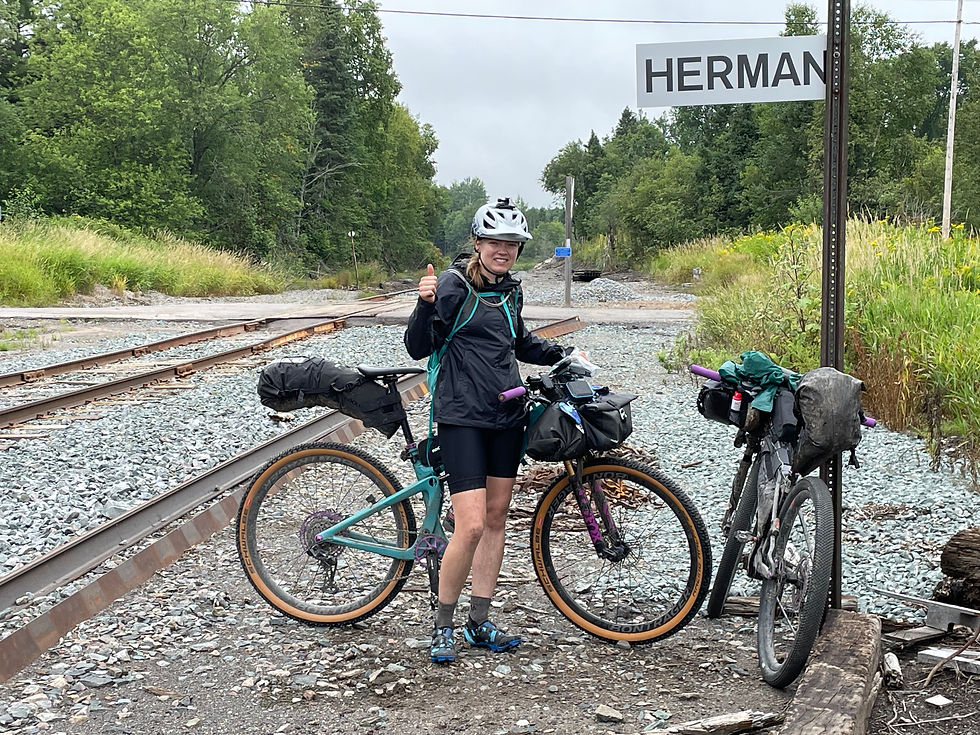



The fourth checkpoint we reached was Mount Curwood, Michigan’s second highest point. As we approached the summit, we were startled to hear a sharp yell through the trees:
“Hey!”
We turned a corner and were greeted by seven “Yoopers” standing next to three side-by-sides. It was weird to see other humans again after so many hours of being alone. The people at Mt. Curwood were incredibly hospitable, and after we explained what the heck we were doing, they offered us as many provisions as they had with them. While we initially declined, we ended up walking away with Gatorades, beer, dry socks, and a hat. After having a delightful conversation with these people and repeatedly declining their generous offer to take us and our bikes back to civilization on their side-by-sides (they were very concerned for us), we rode back down from the summit and on to the next checkpoint.

The next 50 or so miles of our journey would prove to be the most trying of all. As darkness slowly crept in, we decided to forfeit setting up camp in the woods and continued to ride through most of the night, almost nonstop. Todd later told us that this 50-mile segment was the most difficult ever created for a Crusher 225EX event. Thanks, Todd. The miles of extremely technical climbs had us gasping for breath, and the near-absolute darkness was unsettling. I was forced to limit myself to a single light on my bars to conserve battery power on my other lights, and this made visibility a challenge as we navigated treacherous, rocky terrain in practically 2D vision. Around 2:00 in the morning, we heard the angry grunts of what we assumed to be a moose coming from our right side and directly off the side of the trail. We yelled in deep voices to try to scare it away, but it followed us for maybe half a mile, continuing to growl and make loud stomping sounds as it crashed through the trees and bushes. We never saw the creature, as neither of us had a helmet light on at the time and thick foliage obscured our view, which was nerve-racking. Let’s just say it was most definitely not a deer, whatever it was. Awhile later, we reached a checkpoint called the Rock Cut, a narrow gorge with 30-foot sheer cliffs hemming us in on either side. A small creek bed with large boulders and rock slabs ran directly through the center, and we had to hike our bikes directly through it and uphill a ways. Todd told us later that a couple of riders once entered the Rock Cut during the day and spotted two cougars perched on either cliff watching them from above. Maybe it was best that we couldn’t see that far up.
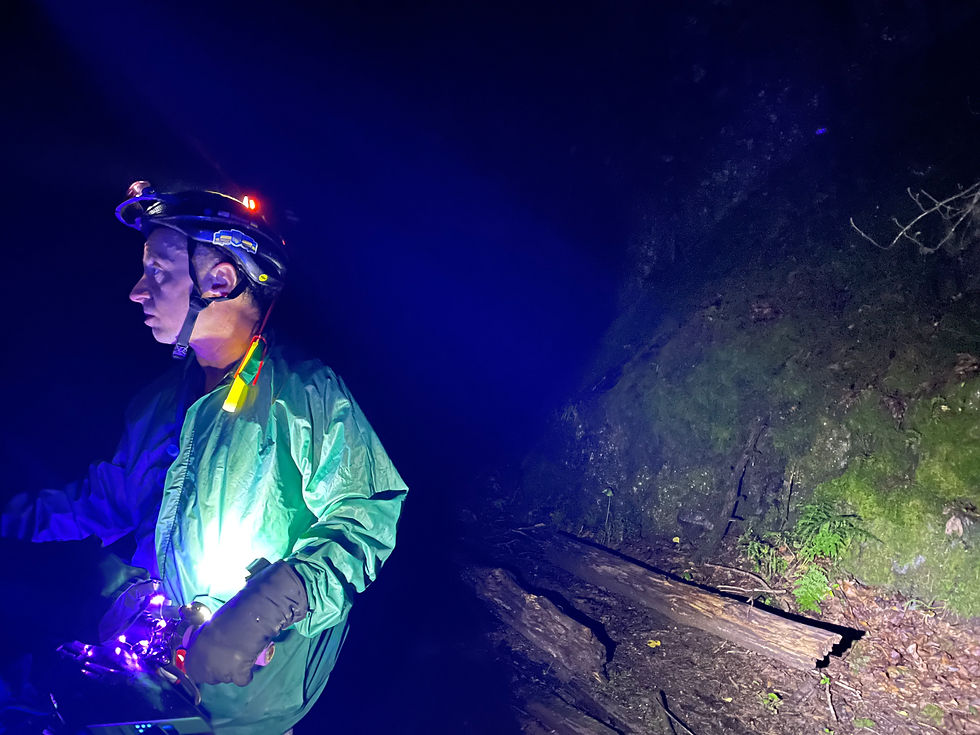
Around 4:30 AM, I began to feel sharp, stabbing pain in my left knee unlike what I had experienced thus far. Despite wanting to continue to ride until daylight, I admitted to Bill that I was physically unable of continuing at that point. Praying that there were no wolves, cougars, bears, or angry moose nearby, we set up camp in a small clearing off the side of the trail. We started a fire in Bill’s camp stove to cook a couple of dehydrated meals, and Bill tended a larger fire for warmth and to dry our soaked socks and other gear. Dinner was a mushroom pasta with a creamy sauce (many thanks to Yum Pouch dehydrated meals!), which we both agreed was delicious. It was the first hot food I had tasted in over 40 hours. After dinner, around 6:00 AM, we finally laid out our bivy sacks, stuffed our sleeping bags inside them, put on our dry, donated socks from Mount Curwood, and slept for about three hours, until 9:00 AM. Three hours may not seem like a lot, but it made a world of a difference for us.

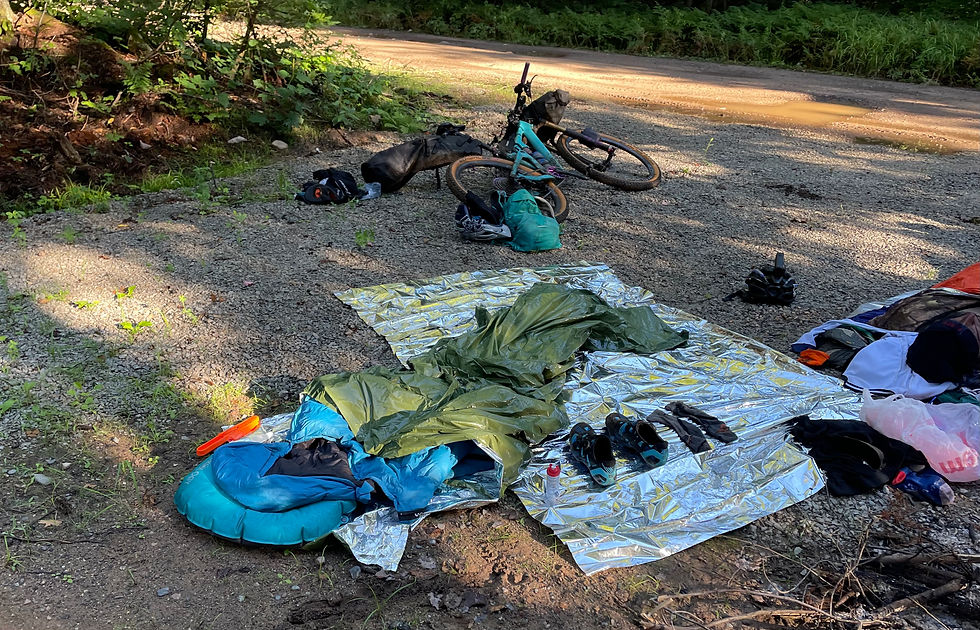
That morning, I awoke to hear a large flock of birds flying overhead. They were screaming something awful, like nothing I’d ever heard before, and I remember thinking they sounded like the flying monkeys from the Wizard of Oz. Despite this strange omen, the warm sunshine set our trepidations at ease, and Bill and I started to pack our gear.
That’s when I realized that my phone wasn’t charging.
I had plugged it in the previous night to our last battery pack, assuming it would be fully charged by the morning. Instead, my phone was at 71%, and we had nothing left to charge it with. A couple of our battery packs could charge using solar power, but that would take between four and seven days in full sun. I was left with the sinking realization that I would have 71% battery to navigate us the last 50 miles of the course. At our current rate of power consumption, that wasn’t going to cut it. The map was a maze of twisting, winding logging roads and two-tracks, and none of the paths we took had street signs. I turned off cellular on my phone, closed any other apps I had open, and I resorted to memorizing the directions as best I could in roughly two-mile segments. Every couple of miles, I would briefly turn on my phone, analyze the next segment of the course, and turn it back off. For each chunk, I would end up memorizing something like this:
“Straight for half a mile, hang left, hang right, hang right, hang left, left turn a mile after that, reassess at the next split.”
The only problem with this system was that occasionally, another logging road would pop up that wasn’t marked on our maps. This caused us to veer off-course a couple of times, and once, we had to backtrack over a mile up a steep hill to get back on course. Despite these expensive mistakes, the system worked. We reached our last checkpoint, Eagle Mine, with 32 miles left to go and 55% battery life. There was a security guard at the mine who was very kind and gave us water and an electrolytes packet. He even made a pot of coffee for Bill. The guard said he was used to seeing some bikers come through as part of this event.
“You guys look much better off than a lot of folks who come through here,” he remarked. “A lot of them are in pretty rough shape.”
Following another grueling five hours of riding, we finally made it back to Koski Corners, the gas station where we began our journey, shortly before 6:00 PM and with 13% battery life to spare. Our total elapsed time was 59 hours, 55 minutes, and six seconds. We were completely and utterly exhausted. As soon as I dismounted my bike, I couldn’t believe the amount of pain I was in, mostly from my knee. It was as if my body had overridden my neurological pain/warning system for the last two and a half days as a survival mechanism, but as soon as we were finished, I was hardly able to stand upright. I gingerly hobbled over to Bill’s van and loaded up my bike and gear.


Upon arriving back at our campsite, a woman we had never met before ran up to us and exclaimed, “Oh thank goodness, you’re both alive! I thought you might have died!” Apparently, through some logistical or clerical error, the campground had expected us to check out of our site that morning. The woman who ran up to us was supposed to be camping on our site, and when she heard about the bike ride we were doing, she began to worry that we didn’t make it. Her concern was very touching!
I suppose this is where I come full circle and explain the impact this race had on me, but to be honest, I don’t think I could ever adequately describe it. I guess it’s one of those things where you have to actually do it to fully understand how life-changing it is. The Crusher was by far the most physically and mentally trying experience both Bill and I have ever had. However, it was also one of the most rewarding, and I feel that it instilled me with newfound self-confidence and strength. Moreover, being immersed in the serene beauty of the wilderness, completely insulated from the distractions of civilization, was both satisfying and freeing. I just might have to move up here someday. One thing is for certain… This will not be my last Crusher.
Here are some closing remarks from Bill:
“The Crusher was by far the most difficult adventure that I could have ever imagined doing. The water crossings, the rain, the rocks, the climbs and the mud, lightning strikes along with the threat of wild animals had me wondering if we would even get out alive. I was definitely worried but then there was the satisfaction of the natural beauty of nature, the lakes, rivers, waterfalls, the smells of the woods, the rustling of the leaves from the wind. Also the wildlife, the turtles, frogs, snakes and even the bees on the wildflowers. Then something about cooking a delicious meal over a portable stove next to a warm fire in the middle of the wilderness with such a kindred spirit near me suddenly didn't seem so bad and made it all worthwhile. The unexpected humor, the laughter and smiles were the icing on the cake. Then we had a wonderful sunset after the rain stopped to enjoy. As difficult as it was, The Crusher has me longing for a trip back and I couldn't have chosen a better riding partner to traverse through Da UP with! ♥️”



Fantastic write-up of the Crusher! Couldn’t make a go of it this year, but reading about it sure makes me want to go again next summer. Thank you for sharing!
Such an adventure, to say the least. Your descriptive writing made the ride come to life! Thanks for sharing and congratulations on the completion of The Crusher!
Mom here. For the record, I knew nothing about The Crusher when I sent you that text! I was simply pointing out that there were people as crazy as you! Little did I know that it would lead to THIS! 🙄